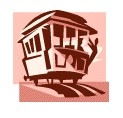Monday, April 19, 2010
Streetcars bring desire
by Larry Geller
 Here’s what Honolulu will miss if it lets Mufi build an expensive elevated rail line.
Here’s what Honolulu will miss if it lets Mufi build an expensive elevated rail line.
This article, from Buffalo Rising, demonstrates the vitality that grade-level transit brings along its right-of-way. Yes, they are referring to the success of Portland, Oregon:
To date, over $3.5 billion has been invested within two blocks of the streetcar system including in excess of 10,000 new housing units and 5.4 million square feet of office, institutional, retail and hotel space. [Buffalo Rising, Streetcars Making a Comeback, 4/19/2010]
With a noisy train overhead and shadows below, Honolulu will be denied that prosperity.
Other cities have caught on, though. The Buffalo Rising article begins:
Tucson, Seattle, Washington DC, Atlanta, Sacramento, Fort Lauderdale, New Orleans, Columbus, Providence, Fort Worth and Salt Lake City are just a few of up to 40 communities currently planning or building streetcar lines. Experts expect up to 22 cities could have lines under construction within two years.
What makes this boom possible is a change in federal policy. The article describes some of the changes and links to this one for more detail:
Up to 22 US cities could be laying track within two years.
Thanks to the Obama Administration, streetcars may soon be reintroduced into many cities that haven’t had them for more than 50 years.
Since the middle of last year, the US Department of Transportation and the Federal Transit Administration (FTA) have largely reversed policies of President George W. Bush that favored bus rapid transit and made it difficult to spend federal funds to build streetcar lines. [New Urban News, Streetcars are poised for a dramatic comeback, 4-5/2010]
As I’ve noted before, the development of a vital retail corridor along the transit route wouldn’t be limited to the Honolulu city center. The same opportunities would be available all along the route to Waianae. That’s right, residential, office, institutional and hotel construction blossoms when low-cost, convenient grade-level transit is available.
Many cities hope to match the success of Portland's system that opened in 1991. Its modern streetcars run on an eight mile loop from Legacy Good Samaritan Hospital, through the trendy Pearl District, downtown, and Portland State University to a new riverfront community- the South Waterfront District. Ridership is nearly four million annually.
That’s nearly four million potential customers to retailers along the right-of-way.
The current plan is much less flexible. While a grade-level system could go right to airport terminals, the current elevated line has an “airport” station that is some distance from the airport. Whether or not it will ever go into Waikiki is problematic since residents will resist having a train roar by their lanai’s or block their view planes. Federal judges have also objected to the elevated train passing by their office windows for security reasons.
Yet the City pushes on. Why? Follow the money.
Mufi’s train benefits developers big enough (and wealthy enough) to build up the station areas. The plan would enrich housing developers whose property values increase in Central Oahu. Of course, these folks are also the ones able to make campaign contributions and support candidates for elective office.
The mom-and-pop store which might see increased business if the tram stopped outside their door can’t match the economic might of developers.
For a video clip of the Portland experience see: Retailers will lose a bonanza if rail passes overhead in Honolulu (10/23/2009). For
(Thanks to Kevin Killeen for pointer to the Buffalo Rising article)
Even the city of Paris has been building trams. But here in Honolulu, we are going to build a big fat system that is going to destroy the one thing that we have to sell - the island's natural beauty. Go Mufi, go!
<< Home



Post a Comment
Requiring those Captcha codes at least temporarily, in the hopes that it quells the flood of comment spam I've been receiving.